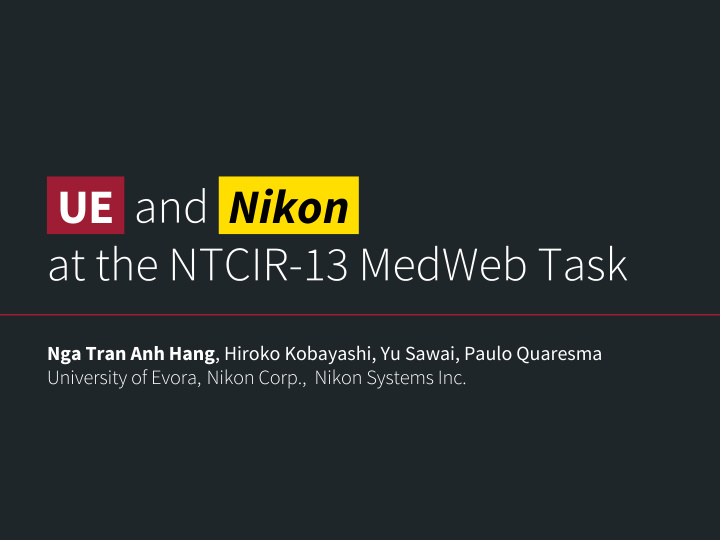



UE Nikon _ Nga Tran Anh Hang , Hiroko Kobayashi, Yu Sawai, Paulo Quaresma
Outline ● Introduction ○ Task Motivation ● Methodologies ○ Rule-based Method (UE-ja-2) ○ Feature-engineering (UE-ja-1, UE-ja-3, UE-en-1) ○ Distributed Representations (UE-en-2, UE-en-3) ● Results and Discussion ● Conclusion 2
Introduction NLP research is focusing on rather “clean” language data. In reality, there are many difficult cases to detect. ● 犬って鼻づまりとかするのかな? (I wonder if dogs get things like stuffy noses?) ● うちのテレビ熱だしすぎで大丈夫かな、これほんと。 (My TV is giving off an awful lot of heat. Is it okay? Seriously.) Table 1. Counts of symptom labels in the training data (1920 pseudo-tweets) 3 1930ja 1930en 犬って鼻づまりとかするのかな? I wonder if dogs get things like stuffy noses? 1955ja 1955en 犬が鼻水垂らしている写真が大好きだ I love photos of a dog with a runny nose. 1975ja 1975en 最近携帯が熱持っちゃう。そろそろ買い替えの My cell phone is hot lately. Time to exchange it for a new one. 時期だ。 2029en 2029ja Do shrimp get the flu? インフルエンザって海老もなるの? 2107en 2107ja My TV is giving off an awful lot of heat. Is it okay? Seriously. うちのテレビ熱だしすぎで大丈夫かな、これほん 2156en と。 I wonder if dogs get colds too 2156ja 2215en 犬も鼻風邪ってひくのかな The picture from my friend is a photo of a dog making a snot bubble, lol! I guess dogs get 2215ja stuffy noses too! 友達の着信の待ち受けが、犬が鼻ちょうちん 2225en 作ってる写真でふいた!犬も鼻づまりとかなるん I didn't know dogs get runny noses. だね! 2231en 2225ja I was sent a photo of a dog with a runny nose. 犬も鼻水たらすんだね。 2261en 2231ja If a bee had allergies, it wouldn't make a living 犬が鼻水垂らしてるしゃしん送られてきた。 2504en 2261ja The dog's runny nose is so cute. Before I knew it I took a picture. 蜂が花粉症だったら商売にならないね 2559en 2504ja Our dog sounds strange lately, I wonder if he has a cold. 犬が鼻水垂らしてるのが可愛くて思わず写真 撮ってしまった。 2559ja 最近のうちの犬の鳴き声が変なんだけど、鼻風 邪ひいたのかな。
Task Motivation ● We want to know strength and weakness of popular methods on “real-world datasets” . 1. Rule based What we 2. Feature engineering guessed... 3. Distributed representations 3 Dataset- size 2 required 1 Robustness 4
Methodology: Rule-based Approach (UE-ja-2) dic dic tweet ● Pre-processing Pre. rule1 rule2 rule3 labels filtering filtering detection Extract nouns (Mecab, NEologd) ○ ● Filtering Use NEGATIVE (not symptoms) dictionary ○ (e.g.” 鳥インフルエンザ (bird flu)”) Use rule (except future phrase “ 明日 (tomorrow)” ) ○ ● Detection of symptoms Use symptoms dictionary ○ influenza インフル、インフルエンザ Diarrhea 下痢 ・・ ・・ 5 Cold 風邪、鼻風邪
Methodology: Feature-engineering Approach (UE-ja-1, UE-ja-3, UE-en-1) tweet Pre. F.E. Post. labels 1. Pre-processing to reduce sparseness and noise 3. Random Forests Normalization of ● characters, nouns For En., replace pronouns ● with special tokens. 4. Post-processing 2. Feature Extraction surface features for robustness, Co-occurrence rules ● semantic features for long-distance relations e.g. Influenza + Fever Surface 1 to 2-grams ● Combined with ● Named-entity (for Ja.) ● rule-based model SRL based features ● (subj. verb. pairs, for Ja.) 6
Methodology: Distributed-representations Approach (UE-en-2, UE-en-3) Context Classification tweet SGLM labels Word by Similarity Vectors Skip-gram Language Model (w/wo sub-sampling) Similarity-based Classification Trained using both ● Symptom-clusters are pre-built ● dry-run and other tweet using dry-run data resources Used cosine similarity ● Fixed-length Context Vectors Built from Word-vectors 7
Results of Japanese Subtask 4th/19 8
Results of English Subtask 4th /12 9
Results and Discussion: Error Analysis ● More knowledge is needed, such as ontology Non-human case : 「犬って鼻づまりとかするのかな?」 ○ ( I wonder if dogs get things like stuffy noses?) ● Discourse level knowledge is needed (Jp corpus) ○ 「インフルかと思って病院に行ったけど、検査したら違ったよ。」 (I thought I had the flu so I went to the doctor, but I got tested and I was wrong.) ● Other things to be mentioned Dealing with dialects: 「あかん」 ○ New-born expressions (newborn words/phrases on the Internet) ○ 10
Conclusions ● Simple methods can achieve good performance! ○ We focused on practical application ○ Applied Rule-based, Feature-engineering based, Distributed-representation based systems ● There are still many things to be improved ○ Handle explicit knowledge of symptoms. ○ Discourse, and causal structure ○ Neologisms, slang, dialects (for Japanese corpus) Thank you! ○ Jokes, time and space detection 11
Appendix 12
Error Statistics (Ja. subtask) 13
Error Statistics (En. subtask) 14
Details of Pre-processing & Custom Dictionary (UE-Ja-1&3) ● Preprocessing Applied normalization used in ○ https://github.com/neologd/mecab-ipadic-neologd/wiki/Regexp ● Custom dictionary Contains nouns which are not chunked properly by ○ MeCab-IPADic-NEologd Also used for normalizing by dictionary-form (原形) entries: ○ e.g. {* 鼻ずまり , 鼻づまり , 鼻詰まり -> 鼻づまり } A word or phrase with *asterisk is marked as spelling or grammatical error. Some metaphorical usages found in dry-run data are also normalized: ○ e.g. { 頭痛の種 , 頭痛のもと -> 面倒事 } 15
Methodology: Distributed-representations Approach ● Sub-sampling of frequent words SOURCE TEXT TRAINING SAMPLE (I, have) I have a headache, so I’ve decided to go home. (I, a) (have, I) I have a headache so I’ve decided to go home. (have, a) (have, headache) (a, I) I have a headache so I’ve decided to go home. (a, have) (a, headache) (a, so) I have headache so I’ve (so, I) decided to go home. a (so, have) (so, headache) (so. I’ve) 16
Recommend
More recommend